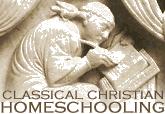Text Only
(Printer-Friendly)
coming soon
Contents
Introduction
Trivium
Grammar
Dialectic
Rhetoric
Homeschool
Curriculum
CCH FAQ
CE Links
Favorite
Reciprocal
What’s New
About CCH
Search CCH
Art History

Classical Christian
Homeschooling:
Classical Education
at Home
WebMaster:
Christine
Miller
CCH’s Online Catalog: 6th Grade History: The Modern World
This page last revised:
June 2002
Copyright © 1997-2002
|
The 18th Century
By the 18th century the religious wars sprung from the Reformation had calmed, and change
of every type flourished - so much so that this century is known as “the century of
revolutions,” as political revolutions took place in many parts of the world, and as
revolutions in science, technology, medicine, farming, industry, transportation, the arts,
and literature flourished.
The 19th Century
Countries continued to search for their own national identities and to control their own
national destinies, through fierce struggles for independence, and wars which enveloped
all of Europe. The only colonies still under the yoke of European control, it seemed, were
those of the British Empire, upon whom the sun never set. Meanwhile, a young man raised on
a hatred of Christianity would take a trip on the Beagle and write a scientific work, even
though he was not trained as a scientist, which offended science, but which, through
propaganda and the help of the clergy, gradually became the standard by which all science
was judged. His name was Charles Darwin.
The 20th Century
In North America, immigrants from the wars and abuses of the Continent poured in as never
before, but in this century, with the country settled and the states established, they
were unable to claim land on the frontier as they had done previously. They crowded into
the cities instead, where the industrial revolution made room for them. Europe still
convulsed with war, as it has done unceasingly, it seems, since the old Roman Empire: as
Germany fought against Europe; the Russian Revolution traded the oppression of the czars
for the oppression of the state; and the greatest war yet, World War II, taught us the
results of Darwin’s philosophy lived out.
Modern World Teacher’s
Resources
World War II birthed technology without which we would not have defeated the Nazis. Since
then, we have been to the Moon and are trying for Mars, we have cloned sheep and grow
babies in test tubes, and our computer technology is the envy of the world. We have
flaunted our modern philosophy, taught to us at Darwin’s knee, in the face of all the
wisdom that has gone before us, even in the face of God. But what will be the result of
technology without morality to guide it? I shudder to think. These essential resources
will help the homeschool parent grasp the big picture.
In lieu of a good in-print narrative history of the Modern Era, The Kingfisher History Encyclopedia could
be used to help the homeschool parent tie the most important events of the 18th century
together for her children. These separate events include: the Scientific Revolution; Peter
the Great of Russia; War of the Spanish Succession; War of the Austrian Succession;
Frederick the Great of Prussia; The Jacobites and Bonnie Prince Charlie; The Seven
Years’ War; Catherine the Great of Russia; Captain James Cook’s Voyages; and the
French Revolution.
 From Jerusalem
to Irian Jaya: A Biographical History of Christian Missions From Jerusalem
to Irian Jaya: A Biographical History of Christian Missions
Ruth A. Tucker
This is the important history that gets left out of most history books:
the history of Christian missions and its effect on the world, the vast majority having
taken place since the seventeenth century. It is a book focusing on the biographies of the
missionaries themselves. Part One covers the Early Centuries--Evangelizing the Roman
Empire (Paul, Polycarp, Perpetua, Ulfilas, Patrick, and Columba), Roman Missions
(Boniface, Anskar, Raymond Lull, Las Casas, Francis Xavier, Matthew Ricci), the Moravian
Advance (Count Nicolaus von Zinzendorf, etc.), and American Indian Missions (David
Brainard, Marcus and Narcissa Whitman, etc.). The rest of the book covers the nineteenth
and twentieth century missions.
 The History of
Science in the Eighteenth Century The History of
Science in the Eighteenth Century
Ray Spangenburg, Diane K. Moser
The age of the Enlightenment brought about not only political, social, and
industrial revolutions, but a scientific revolution as well. “Astronomy, geology,
chemistry, electricity, natural history, and the life sciences are discussed in the
context of social and political developments and the industrial revolution. [This] is a
generally reliable and readable treatment of the breadth of scientific activity in the
century after Newton. . . . The vignettes present enough biographical and contextual
information to make them interesting and colorful, yet convey the important contributions
of the men and women discussed. The authors show sensitivity to the historical context of
the scientific work. The illustrations are well-chosen, often portraying the people
discussed in the conduct of their scientific work. The chronology and glossary are helpful
and reliable. Overall, this is a very good introduction to the subject for the young adult
reader.” --Science Books & Films Review.
 Triumph and
Terror: The French Revolution Triumph and
Terror: The French Revolution
Stephen Otfinoski
The French Revolution was a pivotal event in modern world history, and
influenced events on the European continent and around the world for the next hundred
years. The dramatic changes in French society that occurred between 1788-1815 are examined
to reveal the structure and events within France that led to the revolution, its bloody
Reign of Terror aftermath, and the rise of Napoleon. Triumph and Terror is an in-depth
historical narrative on an important topic.
 Eighteenth
Century World Landmarks Eighteenth
Century World Landmarks
Random House, publishers
The Random House Landmark series, published in the 50’s for 4th
through 6th graders, was an excellent series of historical narratives written by the
greatest American writers of the day. Authors such as Sterling North, Thomas Costain,
Armstrong Sperry, Noel Streatfield and more wrote exciting narratives that brought to life
the most important people and events of American and world history. Even though these
books focusing on 18th century world history are currently out of print, Random House has
begun reissuing titles from this series as well as its American history series, so perhaps
one day soon these will be back in print as well. In Catherine
the Great by Katharine Scherman, we learn of the great monarch of Russia who brought
to it its first breath of justice and equality. Famous
Pirates of the New World by A.B.C. Whipple tells the story of the heydey of piracy in
the 18th century, and of Blackbeard, Captain Flood, Stede Bonnet, and others. Marie
Antoinette by Bernardine Kielty is a biography of the famous queen whose life was
ended by the guillotine during the French Revolution. The
Slave Who Freed Haiti by Katharine Scherman is the story of Toussaint Louverture, the
grandson of an African chieftan, slave on the French sugar plantations of Haiti, who
nevertheless knew of the affairs of history and was dedicated to the rights of man. Captain
Cook Explores the South Seas by Armstrong Sperry tells of the life of that famous
navigator and explorer who discovered the Hawaiian Islands, explored the coast of
Australia, and whose crew was the first to avoid scurvy on a long sea voyage. The
Story of Australia by A. Grove Day tells of the founding of the British colony there
(since England could no longer send its convicts to the newly independent United States of
America) and the vivid narrative of its growth to a world power.
Out of Print. Search AddAll.com
or BookFinder.com via an author and title search;
see locating out of print books.
G. A. Henty’s 18th
Century Historical Fiction:
Orange
and Green, A Tale of the Boyne and Limerick (1690 Ireland) paperback
edition
Bonnie
Prince Charlie, A Tale of Fontenoy & Culloden (1745 Scotland) paperback
edition
With
Clive in India, The Beginnings of an Empire (1786 India)
In the
Reign of Terror, The Adventures of a Westminster Boy (1793 France) paperback
edition
The Tiger
of Mysore, A Story of the War with Tippo Saib (1795 India) paperback
edition
In lieu of a good in-print narrative history of the Modern Era, The Kingfisher History Encyclopedia could
be used to help the homeschool parent tie the most important events of the 19th century
together for her children. These separate events include: the Napoleonic Wars and Empire;
Simon Bolivar and the revolt of the South American colonies; Greek War of Independence
against the Ottoman Empire; Boer Wars in South Africa; 1848 Year of European Revolutions;
German Unification; Italian Unification; Irish Potato Famine; the Crimean War; and the
Reign of Queen Victoria and the British Empire.
From Jerusalem to Irian Jaya: A
Biographical History of Christian Missions
Part Two begins with nineteenth century missions: South Central Asia (William Carey,
etc.), Black Africa (David Livingstone, etc.) the Far East (Hudson Taylor, etc.) the
Pacific Islands, Single Women Missionaries such as Amy Carmicheal and Gladys Aylward,
Student Volunteers, Faith Missionaries such as A. B. Simpson and the Christian and
Missionary Alliance, Medical Missions such as Wilfred Grenfell’s, and Translation
Missions such as Wyclif Bible Translators.
 Napoleon and the
Napoleonic Wars Napoleon and the
Napoleonic Wars
Albert Marrin
This biography of Napoleon relates his humble beginnings, his rise to
power, his glorious Empire, his exile, and final desparate bid for power. But it is also
much more than a biography--it is a narrative history of the times in which Napoleon
lived. Dramatic and gripping, and historically accurate, it details battles and political
strategies, and does not shy away from the grim realities of life in the Empire, or in the
Emperor’s army. After Napoleon was defeated in the Battle of Waterloo, Europe was
forever changed. The Holy Roman Empire, stalwart against all comers since the time of
Charlemagne, was now gone, and the way was paved for the rise of the nationalism
characteristic of the 19th century.
Out of Print. Search AddAll.com
or BookFinder.com via an author search using
’marrin’ and a title search using ’napoleon;’ see locating
out of print books.
 Nineteenth
Century World Landmarks Nineteenth
Century World Landmarks
Random House, publishers
These books are currently out of print, but they are excellent narratives
on different aspects of 19th century history that are difficult to find covered in other
books. In Great
Men of Medicine by Ruth Fox Hume, we learn of the ten greatest men who founded the
science of modern medicine--Vesalius, Pare, Jenner, Koch, Morton, Lister, Banting,
Laennec, Pasteur, and Fleming. Napoleon
and the Battle of Waterloo by Frances Winwar relates the boyhood and life of the great
general throughout the French Revolution and the founding of his empire that changed the
map of Europe. Simon
Bolivar, the Great Liberator by Arnold Whitridge is the story of the brave man who
fought for the freedom of the South American colonies while Spain had troubles of her own
with Napoleon. Garibaldi:
Father of Modern Italy by Marcia Davenport narrates the story of the unification of
Italy, long ruled and fought over by various European nations, following the demise of the
Napoleonic Empire. The
French Foreign Legion by Wyatt Blassingame retells the story of the courageous
Legionnaires and of their Legion founded in 1832 in French colonial Algeria. Royal
Canadian Mounted Police by Richard L. Neuberger tells the exciting story of the first,
most famous, and most efficient police force in the world--that of the brave Canadian
Mounties. Learn of the events of the Crimean War with the founder of modern nursing, Florence
Nightingale by Ruth Fox Hume. Queen
Victoria by Noel Streatfeild tells of the English queen who gave her name to an era,
and who ruled a world-wide Empire upon which “the sun never set.”
Out of Print. Search AddAll.com
or BookFinder.com via an author and title search;
see locating out of print books.
G. A. Henty’s 19th
Century Historical Fiction:
With
Moore at Corunna, A Tale of the Pennisular War (1808 Napoleon in Portugal &
Spain) paperback
edition
Under
Wellington’s Command (1810 Peninsular War with Napoleon) paperback
edition
To Herat
and Cabul, A Story of the First Afghan War (1840 Afghanistan) paperback
edition
For Name
and Fame, With Roberts to Cabul Or, Through Afghan Passes (1879 Afghanistan) paperback
edition
Dash for
Khartoum, A Tale of the Nile Expedition (1885 Sudan) paperback
edition
Facing
Death, Or, the Hero of Vaughan Pit, A Tale of the Coal Mines (1880s Wales) paperback
edition
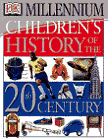 Children’s
History of the 20th Century Children’s
History of the 20th Century
DK Publishers
In 344 lavishly illustrated pages, this history gives a wide overview of
the 20th century by combining DK’s beautiful photos, historical media, month-by-month
timelines, and brief articles that read like journalism. This fascinating reference also
includes special features on the century’s most important events, such as the Russian
Revolution, the Great Depression, and the Space Race. While no one topic is covered in
detail, the overview is wonderful for giving a complete big-picture sense of the times,
and as an interest-building starting place for your child’s further reading and
research.
From Jerusalem to Irian Jaya: A
Biographical History of Christian Missions
The remaining chapters of this book cover twentieth century missions and advances: Radio
Missions such as Peter Deyneka and the Slavic Gospel Association, Missionary Aviation such
as the Jungle Aviation and Radio Service, the shift toward nationalization beginning with
20th century martyrs in the Boxer Rebellion, etc., third world missions such as Paul
Yonggi Cho in South Korea, and the missions of the future, such as Brother Andrew’s
Open Doors, and Don Richardson’s missions in Irian Jaya.
 Carry a Big
Stick: the Uncommon Heroism of Theodore Roosevelt Carry a Big
Stick: the Uncommon Heroism of Theodore Roosevelt
George Grant
Before his fiftieth birthday Teddy Roosevelt had served as a state
legislator, under-secretary of the Navy, police commissioner, Army colonel, governor of
New York, vice president and then President of the United States. Cattle rancher,
biologist, athlete, reporter, editor and writer of nearly fifty books, he was a devoted
family man who raised five children and enjoyed a life-long romance with his wife. He
stands out as one of the greatest leaders in the history of this nation because he used
his accomplishments and gifts for the good of his fellow men. This book gives the reader a
glimpse of the character that made Theodore Roosevelt’s uncommon heroism possible.
Other exceptional Leaders in Action series biographies for the 20th century include Never Give In:
the Extraordinary Character of Winston Churchill by Stephen Mansfield, and Not a Tame Lion:
The Spiritual Legacy of C. S. Lewis by Terry W. Glaspey.
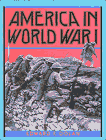 America in World
War I America in World
War I
Edward F. Dolan
Since Albert Marrin’s wonderful The Yanks Are
Coming is out of print, this history of America’s role in World War I is a great
substitute. “This fine work, with large type, an oversize format, and plenty of
photographs, helps redress the problem [of very few World War I books available for
children]. In an understandable, orderly fashion, Dolan explains major events and
personalities, managing to clarify such key questions as how the assassination of the
prince of a small country could plunge the world into war. A few points are separated into
sidebars, and thumbnail summaries of the experiences of several of the war’s
important leaders are presented on a concluding double-spread. With an emphasis on
simplicity, the text touches only briefly on each topic, but it will give young readers a
good working knowledge of ‘The War to End All Wars.’”
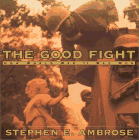 The Good Fight:
How World War II Was Won The Good Fight:
How World War II Was Won
Stephen E. Ambrose
“Packed with photos (color and black-and-white), maps, personal
stories, and concise, readable descriptions of the major events of World War II,
bestselling author Stephen E. Ambrose’s The Good Fight is a stunning resource
for students of history. Though this horrific war has been written about innumerable times
over the last half-century, this chronicle for young readers ... is one of the most vivid,
insightful, and straightforward perspectives around. Ambrose pulls no punches. In the
first paragraph of his introduction, he reminds us that ‘more people were killed,
more houses, apartment buildings, factories, bridges, and other works of man were
destroyed than ever before or since.’ From Hitler’s rise to power to
Japan’s attack on Pearl Harbor to the air war over Europe to the War Crimes Trials,
the major events of the war are thoughtfully examined and depicted. Each chapter features
one of the most important campaigns, players, situations, or battles, with a full-page,
often chilling photograph covering half the two-page spread and inset photos on the
narrative page as well. Quick Facts boxes appear in every chapter to highlight interesting
and relevant details. Large campaign and battlefield maps are interspersed throughout.
Readers will come away with a painfully real sense of what life was like in the 1930s and
’40s for the soldiers, families, women workers (Rosie the Riveter is included, of
course), heroes, and victims of this most devastating, cruel war.” This in-print
narrative will give 6th graders an excellent introduction to World War II, and those that
want to learn more can then find our out-of-print recommendation, Illustrated
Story of World War II by Readers’ Digest Publishers, which was previously
featured here.
 Stalin:
Russia’s Man of Steel Stalin:
Russia’s Man of Steel
Albert Marrin
This riveting biography of Josef Stalin not only narrates with interest
and excitement the events of Stalin’s life, but also of his times. With him we taste
of life under the czars and with him we participate in the ‘People’s
Revolution’--and with him we follow the transformation of that ideal into a tyranny
ruled by one man, the transformation of a backward nation to a world superpower (but at
what cost!). “The man who’d lived in Siberian exile under the tsars built
history’s most vast and inhuman prison system, the slave-labor camps of the gulag.
He played democracy’s most invaluable ally during World War II, then quickly turned
into its most feared enemy with the fall of the Iron Curtain. His death ended a reign of
terror, yet his spirit still overshadows the nation he built.” Other exceptional
Marrin biographies of world leaders that have greatly affected the modern era include Hitler
and Mao
Tse-Tung and His China, also, regretfully, out of print. If you cannot find a copy
with the used book searches, try inter-library loaning it from your local library.
Out of Print. Search AddAll.com
or BookFinder.com via an author and title search;
see locating out of print books.
 Twentieth Century World Landmarks Twentieth Century World Landmarks
Random House, publishers
These books are currently out of print, but they are excellent narratives
on different aspects of 20th century history that are difficult to find covered in other
books. In The
Conquest of the North and South Poles by Russell Owen, Peary’s heroic push for
the North Pole in 1909, and Admundson’s, Scott’s, and Byrd’s expeditions to
the South Pole in 1911 and in the 1920’s are brought to life. Flying
Aces of World War I by Gene Gurney retells of World War I and the introduction of the
airplane into combat; find out the true story of the Red Baron. Lawrence
of Arabia by Alistair MacLean is the fascinating story of British soldier T. E.
Lawrence and his fight against the Ottoman Turks for an independent Arabia, the Turks
siding with Germany in World War I. The
Man Who Changed China by Pearl S. Buck is the story of Sun Yat-sen, who in 1921
overthrew the Manchu emporers and set up a democratic republic, which soon fell under the
control of the Communist party. The World War II Landmarks include The
Rise and Fall of Adolf Hitler by William L. Shirer, The
Sinking of the Bismarck by William L. Shirer, Commandos
of World War II by Hodding Carter, The
Battle of Britain by Quentin Reynolds, and Winston
Churchill by Quentin Reynolds. The
Story of Atomic Energy by Laura Fermi tells of the development of nuclear power, used
in World War II in the Atom Bomb, and subsequently for peaceful purposes in nuclear power
plants. Ben
Gurion and the Birth of Israel by Joan Comay tells of the miraculous story of the
founding of the modern nation of Israel following World War II, which was prophesied in
the Old Testament thousands of years ago. The
War in Korea: 1950-1953 by Robert Leckie tells of the first war fought in modern times
with the oversight of the United Nations. The
Story of Albert Schweitzer by Anita Daniel is the biography of one of the greatest
Christians of the 20th century, and his untiring missionary and medical work in the
African Congo. Dr. Schweitzer was awarded the Nobel Peace Prize in 1952. Exploring
the Himalaya by Supreme Court Justice William O. Douglas relates the exciting and
demanding conquest of the highest mountain in the world, Mount Everest.
Out of Print. Search AddAll.com
or BookFinder.com via an author and title search;
see locating out of print books.
 Marching to
Freedom: The Story of Martin Luther King Jr. Marching to
Freedom: The Story of Martin Luther King Jr.
Joyce Milton
“You get up now!” The bus driver told the young black boy to
move to the back of the bus. But fourteen-year-old Martin Luther King, Jr. did not move.
“Come on now, M.L.,” said his teacher. “We have to move. It’s the
law.”
Martin Luther King, Jr. moved to the back of the bus that day in 1943, but he never forgot
how it made him feel. When he became a man, he fought to change that law and all others
that denied black people their rights. Martin Luther King, Jr. began ‘Marching to
Freedom,’ and many people--both black and white--followed him. - from the Publisher.
Rather than a complete history of the civil rights movement, this biography of its
greatest champion, and one of the greatest Americans of the 20th century, lets our
children see what life was like through the eyes of Dr. King. The other events of the
civil rights movement with which every American should be familiar can be learned from
DK’s Children’s History of the 20th Century.
 Project Apollo Project Apollo
Ray Spangenburg, Kit Moser
“Space travel was an alien concept until 1957 when the former Soviet
Union launched Sputnik I, the first artificial satellite, followed quickly by the United
States’ Explorer I. Then in 1961 came a challenge from President John F. Kennedy to
put a man on the moon. Project Apollo is the chronology of the space program during
this historical time period. Written in story form, all aspects of the space program are
covered, supplemented by maps and pictures. The race between the Soviet Union and the
United States to put a man on the moon, the astronauts who participated, and the political
implications of the program are all included. Part of the ‘Out Of This World’
series, this well-done reference book is equally enjoyable as a storybook. There are
exceptional resources listed for those interested in further study, and a space travel
timeline, which gives the overview of the program.” Couple this book with the
biographical novel Rocket Boys
by Homer Hickam, and The Astronomy
Book by Dr. Jonathan Henry for a fascinating unit study on space exploration and
astronomy.
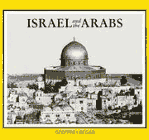 Israel and the
Arabs Israel and the
Arabs
Geoffrey Regan
From the excellent Cambridge Introduction to World History series. Israel
and the Arabs provides an account of the Middle East conflict, beginning with the
British rule of Palestine following World War I (reading the Random House World Landmark Lawrence
of Arabia by Alistair MacLean recommended above will
explain how Britain ended up with Palestine), continuing through the founding and
development of the Jewish state of Israel, the growth of Arab nationalism, and the PLO and
the Lebanon War. The many wars begun by the Arab states against Israel since its
foundation are included. A number of primary sources, and questions encouraging readers to
examine situations and events, updates this account of the Middle Eastern conflict and the
historical events that prefaced it.
Out of Print. Search AddAll.com
or BookFinder.com via an author search using
’regan’ and a title search using ’israel and the arabs;’ see locating out of print books.
Modern Literature:
Robinson Crusoe by Daniel DeFoe
(early 18th century)
Treasure Island by Robert
Louis Stevenson (18th century)
Oliver Twist by Charles Dickens
(Victorian era London)
The Call of the Wild by Jack London
(Alaskan gold rush)
and Twenty Thousand Leagues Under the Sea
by Jules Verne (turn of the century science fiction), from 6th Grade Literature selections
This online catalog is made possible through an association with Amazon.com.
Clicking on the book cover will take you to Amazon’s information page about that
book. You can look at its price, availability, any discounts currently taken for that
title, reviews of the book, and other information, as well as order it if you decide to
purchase the book. You can even place books in your shopping cart and save them for
purchase at a later time. You can continue to add or delete books from your shopping cart
until you are satisfied with your order and ready to purchase. Clicking on your
browser’s “Back” button will bring you back to this catalog.
Locating Out of Print Books
Sometimes books go out of print, or the publisher runs out of stock. Any book not
available from Amazon.com for any reason can be searched using AddAll.com, a book shopping site which will scan Amazon
as well as Barnes and Noble, Powell’s Books, Book Close Outs and many other new and
used book sites. Be sure to also check BookFinder.com
for out of print book searches.
If all else fails, and you cannot find a book you need, check it out from
the library, or request it from your library through interlibrary loan. Once you have the
book home, take it to a copy store and copy it. You can even have color copies done of key
maps or photographs. Copy stores can now do nice bindings on your copy projects. The copyright law allows copying of out of print
(not in print) works to be used for educational purposes. Then return the book to the
library, and you have your own book to keep, usually for less than it would be from a
collector’s book shop.
Still have questions? Ask
me!
 
|
